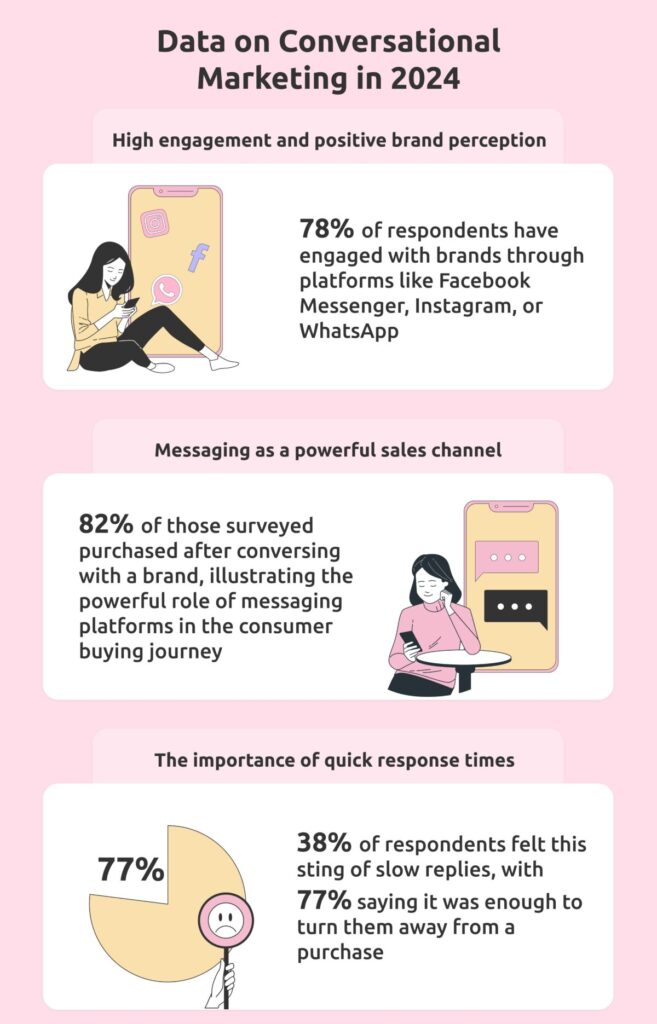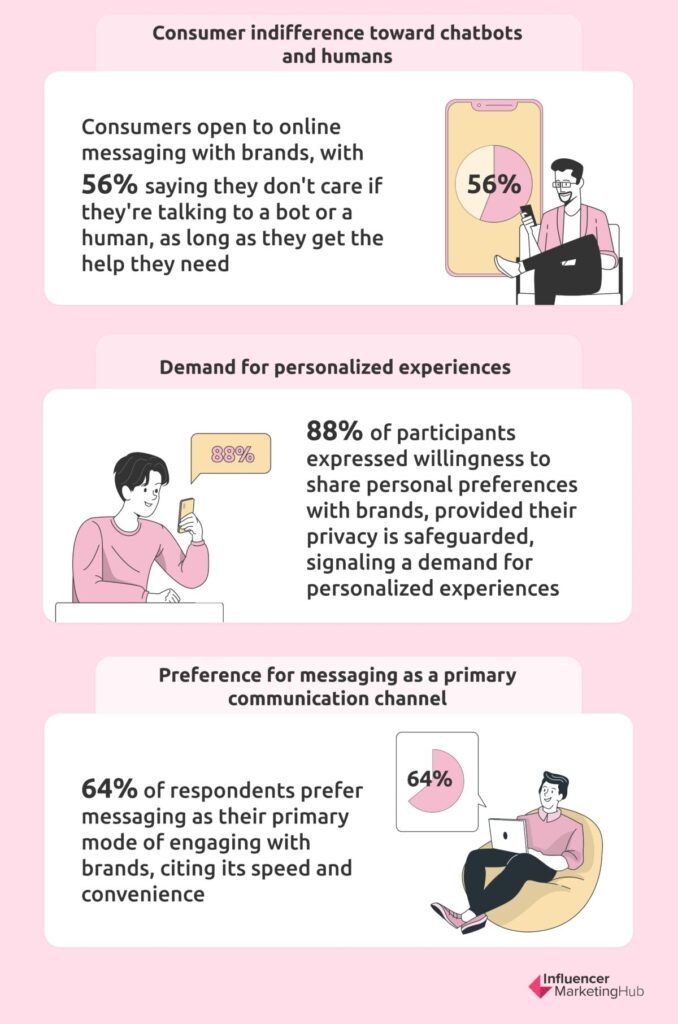You're a marketing director of a tech startup, struggling to engage a tech-savvy audience who craves instant gratification and personalized experiences. Traditional marketing tactics fall short in capturing the attention and loyalty of this demographic, leading to stagnant growth and low customer retention.
Conversational marketing offers a dynamic and interactive way to connect with customers in real time. Leveraging chatbots and messaging platforms delivers personalized recommendations, gathers valuable customer insights, and fosters meaningful relationships that resonate and drive brand loyalty and revenue growth.
Let's explore what conversational marketing is and how you can build a strategy that converts.
Guide to Conversational Marketing in 2024 (Trends, Tips & Examples):
- What is Conversational Marketing?
- How Does Conversational Marketing Work?
- What Are the Types of Conversational Marketing?
- What Are the Benefits of Conversational Marketing?
- How Does Conversational Marketing Improve Customer Relationships?
- Key Elements of a Successful Conversational Marketing Strategy
- Conversational Marketing Statistics in 2024
- Top conversational marketing platforms
- 1. Birdeye
- 2. Drift
- 3. Intercom
- 4. Podium
- Conversational Marketing Trends in 2024
- Frequently Asked Questions
What is Conversational Marketing?
Conversational marketing is a strategy that engages and builds relationships with customers using personalized, real-time conversations. It uses chatbots, live chat support, social media messaging, and other communication tools to interact with customers conversationally.
It creates a seamless and interactive experience for customers, where they can ask questions, get recommendations, and receive personalized assistance that feels human (even when it's not...thanks ChatGPT). In other words, you're creating dialogue with customers rather than just pushing out one-way messages.
How Does Conversational Marketing Work?
Conversational marketing leverages real-time, one-to-one connections between marketers and customers. It listens to customer needs and responds directly to those needs through conversation. This enhances the customer experience, builds stronger relationships, and drives sales by providing immediate value, answering questions, and guiding customers through their buying journey.
By engaging with customers through these channels, businesses can build relationships and provide personalized support that meets the unique needs of each individual.
Conversational marketing consists of four basic steps.
1. Engagement
The process begins with engaging the customer through live chat on a website, social media, messaging apps, or chatbots.
For example, a potential customer comments on a post about moisturizers, asking for recommendations for sensitive skin. The chatbot immediately responds, inviting the customer to a private conversation to learn more about their needs.
2. Understanding
The next step is understanding the customer's needs once engagement begins. This involves asking the right questions and actively listening to the customer's responses. The goal is to gather enough information to provide a personalized and relevant solution.
Using the same example as above, the chatbot asks a series of questions, gathering information about the customer's skin type, preferences, and any specific concerns they have (e.g., allergies, budget).
3. Recommendation
The company then provides recommendations, advice, or solutions. This could range from suggesting a specific product, offering a demo, or providing information that moves the customer closer to a decision.
For instance, based on the customer's responses from above, the chatbot recommends a specific moisturizer designed for sensitive skin, highlighting its benefits and key ingredients. It also shows reviews from customers with similar skin types.
4. Action
Finally, the conversation leads the customer towards a specific action — making a purchase, booking a consultation, or completing another step in the company's sales funnel.
For example, the chatbot provides a link to the product page where the customer can learn more and purchase. It also offers a special discount code for first-time buyers to encourage immediate action.
What Are the Types of Conversational Marketing?
There are several examples of conversational marketing:
- Live chat support: Have you ever visited a website and had a little chat box pop up in the corner, offering to help? That's live chat support in action. For example, when shopping online for a new pair of shoes and having a sizing question. A friendly chat agent appears to assist you in real time, ensuring you find the perfect fit.
- Chatbots: These little guys are virtual assistants that can answer customer queries instantly. Let's say you're browsing a beauty website looking for the perfect shade of lipstick. A chatbot asks about your preferences and then recommends the ideal product based on your answers.
- Social media messaging: Who doesn't love sliding into those DMs? Businesses can use social media messaging platforms to engage with customers directly on platforms like Facebook Messenger or Instagram. Imagine reaching out to a clothing brand on Instagram with questions about a specific item, and receiving personalized recommendations in your inbox.
- Email marketing automation: Yes, even email can be conversational. With email marketing automation, businesses can send personalized messages triggered by customer actions. For instance, signing up for a newsletter could trigger an email series tailored to your interests, providing helpful tips and product recommendations along the way.
Conversational marketing is about creating meaningful connections with customers through engaging conversations. So go ahead, get chatting.
What Are the Benefits of Conversational Marketing?
Conversational marketing isn't just a trend, it's a game-changer. Businesses and customers can finally have a heart-to-heart without the awkward "Please hold; your call is important to us" interlude.
Here's a look at the benefits conversational marketing offers to brands:
- Instant gratification: In a world where waiting over two seconds for a video to load is a sin, conversational marketing delivers answers faster than you can say "microwave popcorn." It's the digital equivalent of a genie in a bottle, minus the three-wish limit.
- Personalization on steroids: Ever had a chat with someone who gets you? That's conversational marketing in a nutshell. It's like your best friend who knows you're a sucker for a good sale and points you directly to the bargains. No more sifting through irrelevant stuff; it's all about you.
- Feedback loop: Imagine shouting into the void and hearing a response. That's the feedback magic of conversational marketing. It's a two-way street where your voice doesn't just echo back; it sparks a conversation, leading to improvements, innovations, and, sometimes, a hearty laugh.
- Sales without the sleaze: Let's face it, no one likes to be sold to, but everyone likes to buy. Conversational marketing is the art of guiding without pushing, like a friend leading you to the best pizza in town without making you feel you've been lured into a timeshare presentation.
- Builds relationships: Remember the barista who knows your order by heart? That's the vibe. Conversational marketing turns interactions into relationships, making customers feel seen, heard, and valued. It's not just about making a sale; it's about making a friend (who happens to buy stuff).
How Does Conversational Marketing Improve Customer Relationships?
Turning shoppers into customers and customers into brand ambassadors is possible when you build relationships with buyers.
Let's review how conversational marketers enhance relationship building:
- Breaking the ice: Ever walked into a party where you knew no one? Awkward, right? Conversational marketing is that friendly nudge, the icebreaker that turns awkward silence into engaging banter. It makes the first move so customers don't have to.
- Mind Reading (sort of): Envision if you could anticipate every customer question or need. With conversational marketing, it's almost like you can. By analyzing past interactions, you can tailor conversations that hit at the heart of what your customer is thinking (aka needs in their current state of their buyer journey). No crystal ball needed.
- 24/7 buddy system: Ever had a question at 3 a.m. and wished someone was awake to answer? Conversational marketing tools are those night-owl friends, always there, always ready to chat. It's like having a 24/7 open line to your customers, making them feel supported and heard, day or night.
- No more awkward silences: You know that moment when you've run out of things to say? Yeah, conversational marketing doesn't. It keeps the dialogue flowing, ensuring customers never feel abandoned. It's like always having the perfect witty comeback or insightful comment to keep the conversation going.
- Building trust one chat at a time: Every conversation is a brick in the trust fortress you're building with your customers. With each interaction, you're not just solving problems; you're showing them they matter. It's the difference between a handshake and a warm hug.
- Turning OOPS into WOOPS: Made a mistake? Conversational marketing allows you to turn that oops into an opportunity. Addressing issues in real time, with empathy and efficiency, can turn a potential deal-breaker into a showcase of your commitment to customer satisfaction.
Key Elements of a Successful Conversational Marketing Strategy
So what's the secret sauce that makes a conversational marketing strategy not just good but "Where have you been all my life?" great? It's like assembling the ultimate playlist for a road trip; every element has to match the mood at the right time, or customers will tune you out.
Here's a look at the elements of building a conversational marketing strategy that converts:
- Personalization is key, not creepy: Think of personalization like being a good party host. You remember names, preferences, and maybe that one guest who's allergic to peanuts. Use your knowledge to make interactions feel tailored and special, but don't overstep. It's a fine line between "Wow, they get me!" and "Wait, how do they know that about me?"
- Timing is everything: Ever had someone text you at 4 a.m.? Annoying, right? The same goes for conversational marketing. It's about offering helpful advice or deals at the right time, not interrupting dinner. Be the message they're happy to see, not the one they swipe away.
- Keep it real: No one likes talking to a robot pretending to be human. If you're using chatbots, make sure they're smart, helpful, and, occasionally, willing to admit their robotic limitations. There's charm in honesty. "Oops, I'm still learning. Let me get a human to help with that," is way better than spiraling into a nonsensical chat loop.
- Feedback loops are gold: Constructive feedback is like finding money in your old jeans. It's a pleasant surprise that can only lead to good things. Encourage it, cherish it, and most importantly, act on it. Your conversational marketing strategy should evolve based on what your customers tell you. It shows you're listening, and that's always in style.
- Seamless integration: Your conversational tools should fit into your customer's journey like the perfect puzzle piece, not stick out like a sore thumb. Whether it's chatbots on your website, messaging apps, or social media platforms, the transition should feel as smooth as butter on warm toast.
- Analytics, because guessing gets you nowhere: Use data to refine and improve. Which messages are hitting home runs? Which ones are striking out? Analytics take the guesswork out, letting you tweak your strategy with the precision of a master chef seasoning a gourmet meal.
A killer conversational marketing strategy is like being the best kind of friend: attentive, supportive, genuinely interested, and always there when needed. Mix these elements with a dash of creativity, and you have a recipe for building lasting relationships and driving growth.
Conversational Marketing Statistics in 2024
Wondering how well conversational marketing works in the real world? Well, here are a few stats that show its the future of marketing.
High engagement and positive brand perception
Who'd have thought that engaging in a little digital dialogue could boost your brand's image? Roughly 78% of respondents in a Spectrm report have engaged with brands through platforms like Facebook Messenger, Instagram, or WhatsApp. And 86% of those chats left them with a warm, fuzzy feeling about the company.
This high engagement rate shows the shift towards digital communication channels, highlighting the importance of immediacy and convenience in enhancing brand reputation.
Messaging as a powerful sales channel
Yes, conversational marketing can lead to tangible results that matter -- aka sales.
An impressive 82% of those surveyed purchased after conversing with a brand, illustrating the powerful role of messaging platforms in the consumer buying journey. This suggests that messaging serves not only as a customer service tool but also as an influential sales channel, capable of driving conversions through timely interactions and guidance.
The importance of quick response times
In a world where patience is as thin as the latest smartphone, quick response times in conversational marketing have become the holy grail of customer satisfaction. Imagine waiting for a reply in a world that moves at the speed of a tweet.
Not fun, right?
Well, 38% of respondents felt this sting of slow replies, with 77% saying it was enough to turn them away from a purchase. This stat is a wake-up call for brands everywhere, emphasizing the need to be quick on the draw with responses, whether through lightning-fast human customer service teams or sleek, automated chatbots. Because in the digital age, a slow reply isn't just an inconvenience; it's a deal-breaker.
Consumer indifference toward chatbots and humans
Do shoppers prefer people or bots when getting information from brands? The answer may surprise you. Or not...especially knowing that screens are the second home of today's consumers. In fact, you may find some who prefer to chat vs. call a company to get help.
They're not just open to online messaging with brands; they're diving in headfirst, with 56% saying they don't care if they're talking to a bot or a human, as long as they get the help they need. This laid-back attitude towards digital dialogue is opening up new avenues for brands to streamline their customer service, mixing AI-driven chatbots for the simple stuff with human touch for the trickier questions. It's the best of both worlds, optimizing resources while keeping customers satisfied.
Demand for personalized experiences
Marketers that were shook by the iOS update are seeing a light at the end of the tunnel. You no longer have to swipe customer data from consumers...they're willing to give it.
A staggering 88% of participants expressed willingness to share personal preferences with brands, provided their privacy is safeguarded, signaling a demand for personalized experiences.
By adopting privacy-first personalization strategies, companies can meet and exceed customer expectations, ensuring every interaction is as unique as the individual on the other side of the screen. This on-demand marketing approach fosters a deeper connection with consumers, setting the stage for a more engaging, satisfying customer journey.
Preference for messaging as a primary communication channel
Folks today are texting more than they use voice communications. But is that really surprising?
Spectrm's report shows 64% of respondents prefer messaging as their primary mode of engaging with brands, citing its speed and convenience.
This preference highlights the necessity for brands to prioritize messaging as a key communication channel, investing in its development to offer seamless, efficient interactions that meet consumer expectations.
Top conversational marketing platforms
So which tools should you use to implement conversational marketing into your strategy? Here are several we recommend.
Features: Birdeye combines reputation management with conversational marketing. It allows businesses to collect reviews, send surveys, and engage with customers across multiple channels. Birdeye aims to provide a holistic view of customer interactions and feedback. Pricing: Birdeye offers customized pricing based on the services and features your business requires. You’ll need to fill out a form to receive personalized quote. More information can be found on Birdeye’s pricing page. Features: Drift specializes in conversational marketing through chatbots and personalized messaging. It aims to convert website visitors into leads by offering real-time interactions. Features include AI-driven chatbots, meeting scheduling, and lead qualification. Pricing: Drift starts at $2,500/mo, then requires you to contact them for advanced and enterprise-level plans. Features: Intercom is known for its user-friendly interface and powerful messaging tools. It offers targeted messaging, chatbots, and a suite of engagement tools to improve customer support and sales. Intercom focuses on creating a seamless communication flow across the customer journey. Pricing: Pricing for Intercom is based on the size of your business and the specific features you need. They offer a starter package for small teams at $39/mo, with more comprehensive plans ($99/mo and $139/mo) available for larger organizations. Visit Intercom’s pricing page for more information. Features: Podium focuses on messaging, reviews, and payment solutions to enhance customer interactions. It allows businesses to communicate with customers via text, manage online reviews, and process payments, all within a single platform. Pricing: Podium provides two plans starting at $399/mo and moving up to $599/mo. Then there’s a personalized pricing option if you need something unique. For further details, visit Podium’s pricing page.1. Birdeye
2. Drift
3. Intercom
4. Podium
Conversational Marketing Trends in 2024
What does the future hold for conversational marketing? From what we can tell, the future looks bright. Here's a look at the trends we expect to grow in 2024.
Real-time, AI-driven chatter
In 2024, conversational marketing is all about the now. Customers don't just want answers, they want them yesterday. AI-driven chatbots and virtual assistants are the new norm, providing instant gratification and making sure every customer feels like the only customer. It's like having a personal shopper in your pocket, ready to chat 24/7.
- Chatbots and virtual assistants are providing instant responses, catering to customers who expect immediate gratification.
- AI is being used to personalize conversations, offering shopping advice and support that feels uniquely tailored to each customer.
The rise of video and AR/VR
Move over, text-based content; 2024 is all about getting up close and personal with video and AR/VR. Brands are diving headfirst into immersive experiences, giving customers a virtual test drive of products from the comfort of their couch. It's like window shopping, but you don't need to leave your house.
- Conversational marketing is incorporating short-form video content to capture the attention of customers with decreasing attention spans.
- Augmented Reality (AR) and Virtual Reality (VR) are being integrated into chat experiences, creating immersive product demonstrations and virtual showrooms.
Sustainability and ethical marketing
In 2024, you're not on the scene if you're not green. Consumers are savvy and want to know that their purchases are as good for the planet as they are for their Instagram feed. Brands are stepping up, showing off their eco-friendly and ethical creds like a badge of honor.
- Conversational marketing is reflecting consumer values by emphasizing transparency and ethical practices in interactions.
- Brands are using chat platforms to communicate their sustainability efforts and ethical credentials, aligning with consumer expectations.
Hyper-personalization is the new black
Gone are the days of one-size-fits-all marketing. In 2024, it's all about hyper-personalization. With big data and analytics, brands are crafting experiences so personal, you'd think they read your diary. It's like getting a birthday gift that's exactly what you wanted, without having to drop any hints.
- Data-driven strategies are enabling hyper-personalized conversational marketing, with content and recommendations tailored to individual preferences.
- The personal touch in conversations is becoming more prevalent, with marketing feeling like a one-on-one conversation.
Minimalism in marketing
In a world where everyone's shouting, the quiet ones stand out. Minimalism in marketing is all about cutting the clutter and delivering a clear, concise message. It's the marketing equivalent of fresh air in a smog-filled city.
- Conversational marketing is adopting a minimalist approach, focusing on delivering clear and concise messages to avoid overwhelming customers.
- The minimalist trend is influencing the design of chat interfaces and the way messages are crafted, ensuring the essence of the message is communicated effectively.
Continue the Conversation with Your Customers
As we close the book on our exploration of conversational marketing trends for 2024, it's evident that the future of marketing is not just about talking at customers, but engaging with them in meaningful, dynamic conversations.
The rise of AI-driven chatbots, immersive AR/VR experiences, and the push towards sustainability and ethical practices reflect a broader shift in consumer expectations. Customers today crave authenticity, personalization, and experiences that not only meet their immediate needs but also resonate with their values.
The minimalist approach in marketing, emphasizing clarity and simplicity, underscores the importance of cutting through the noise to deliver messages that truly matter. As we look ahead, the brands that will thrive will leverage these trends to foster genuine connections, build trust, and create memorable experiences.
The future of marketing is conversational, and it's a future full of exciting possibilities. For those eager to continue the journey and explore how these trends intersect with the evolving world of influencer marketing, check out our guide on conversational commerce. Your next big idea may be just a click away.
Frequently Asked Questions
How do you do conversational marketing?
Imagine you’re hosting a dinner party. You wouldn’t just talk at your guests all night, right? Conversational marketing is like being the perfect host. You ask questions, listen to the responses, and tailor the conversation based on your learning. Start with a chatbot that doesn’t sound like it’s running for office, sprinkle in some personalized emails, and voilà, you’re not just talking; you’re conversing.
How effective is conversational marketing?
If done right, it’s like having a secret weapon. Conversational marketing cuts through the noise like a hot knife through butter in a world where everyone's inbox is a battlefield. It boosts engagement, drives sales, and builds relationships that aren’t just based on, “Hey, buy this now!” Think of it as turning casual browsers into loyal brand advocates, one meaningful conversation at a time.
What is an example of conversational marketing?
Picture this: You visit a website, and a chat window pops up (not in an annoying way). It’s like the digital version of someone offering you a cup of coffee. This friendly bot asks what you’re looking for today, guides you based on your responses, and maybe even cracks a joke or two. Before you know it, you’ve found exactly what you need, and hey, you might even come back for that delightful chat experience.
What brands use conversational marketing?
From the cool tech startups to the big leagues, many brands are jumping on the conversational bandwagon. Spotify uses it to help you find your next favorite track. Sephora’s chatbot is like your personal beauty consultant. And who could forget Domino’s Pizza, where you can order your pizza through a chat (or even a tweet)? These brands have mastered the art of talking with their customers, not at them, making every interaction feel like a chat with a friend.










